Comprehensive ERP Implementation Proposal for UBank, Australia
VerifiedAdded on 2022/08/23
|19
|4569
|18
Report
AI Summary
This report offers a comprehensive implementation proposal for an Enterprise Resource Planning (ERP) system tailored for UBank, an Australian direct bank. The proposal begins with an executive summary, followed by an introduction that explains the context and justification for ERP implementation, including a cost-benefit analysis and feasibility study. The report then delves into the system design and analysis, detailing how the ERP system should be developed, tested, and implemented, including various testing methodologies and implementation strategies such as phased rollout and big bang approaches. Post-implementation activities, project management, risk management, and change management strategies are also extensively discussed to ensure a successful ERP deployment. The report covers UBank's organizational context, internal and external operating environments, the identified problems and opportunities for IS/IT, and the rationale for ERP adoption. Furthermore, the report outlines the development, testing, and implementation processes, including the use of core and implementation testing teams. The report concludes by demonstrating project management, risk management, and change management strategies related to the case study.
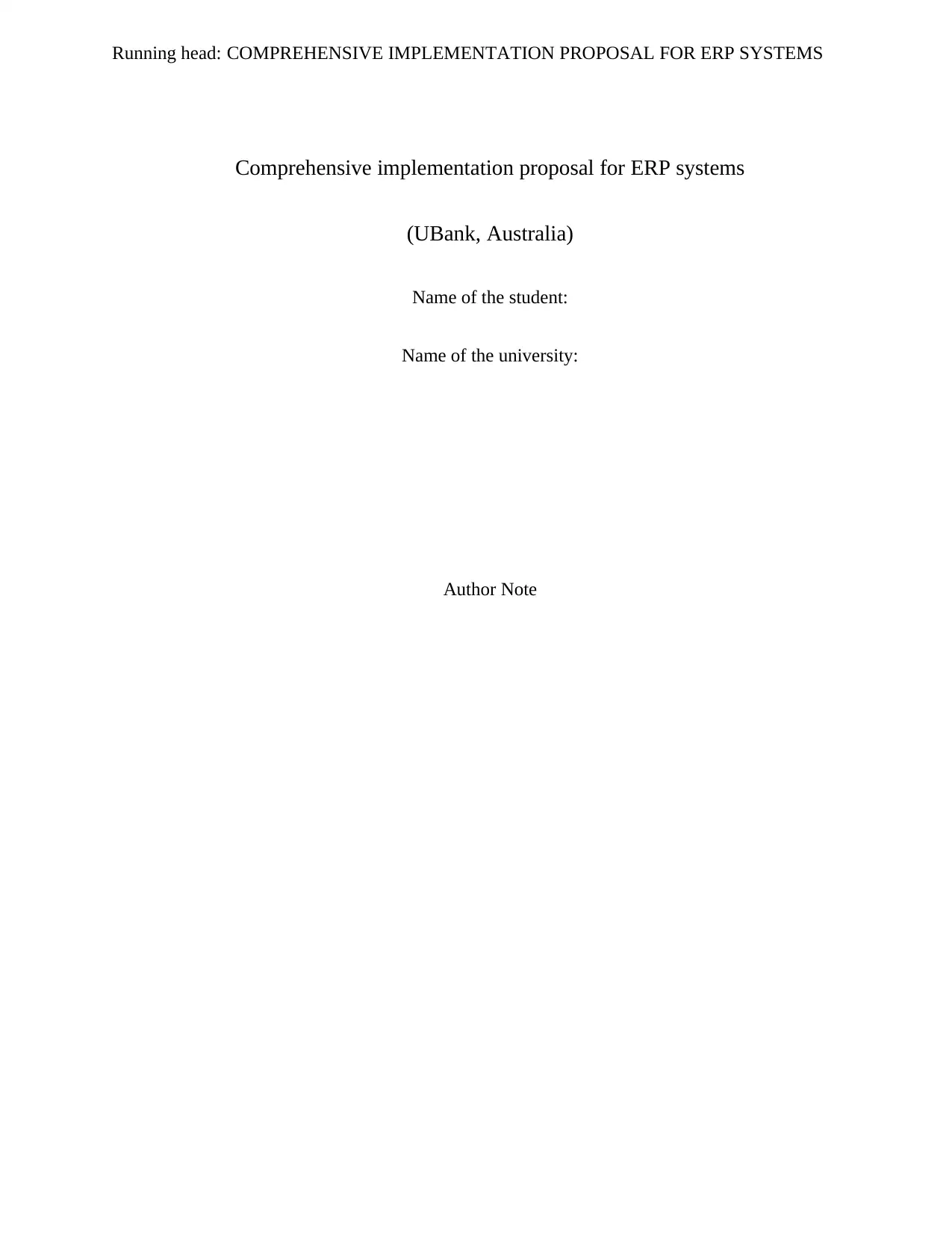
Running head: COMPREHENSIVE IMPLEMENTATION PROPOSAL FOR ERP SYSTEMS
Comprehensive implementation proposal for ERP systems
(UBank, Australia)
Name of the student:
Name of the university:
Author Note
Comprehensive implementation proposal for ERP systems
(UBank, Australia)
Name of the student:
Name of the university:
Author Note
Paraphrase This Document
Need a fresh take? Get an instant paraphrase of this document with our AI Paraphraser
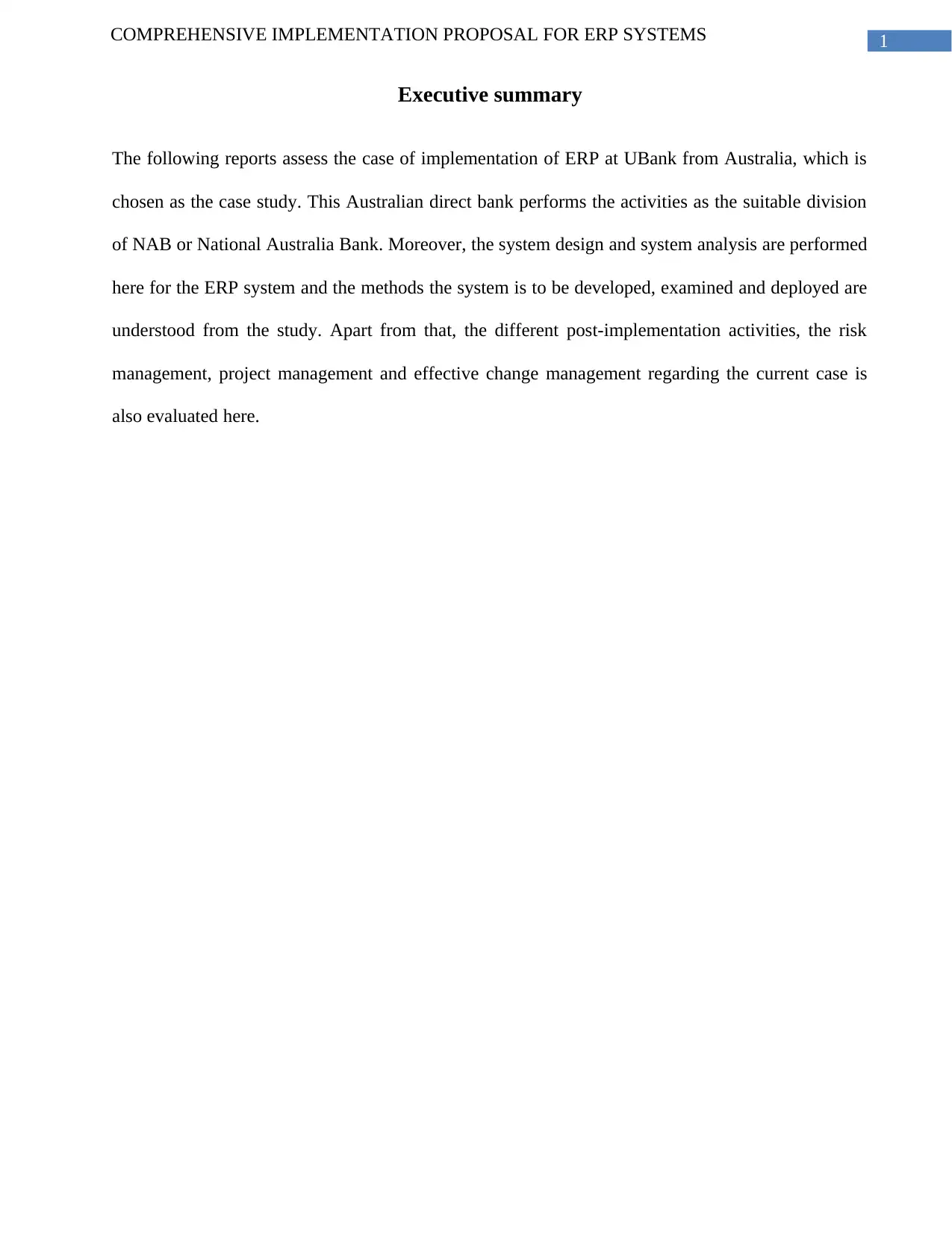
1COMPREHENSIVE IMPLEMENTATION PROPOSAL FOR ERP SYSTEMS
Executive summary
The following reports assess the case of implementation of ERP at UBank from Australia, which is
chosen as the case study. This Australian direct bank performs the activities as the suitable division
of NAB or National Australia Bank. Moreover, the system design and system analysis are performed
here for the ERP system and the methods the system is to be developed, examined and deployed are
understood from the study. Apart from that, the different post-implementation activities, the risk
management, project management and effective change management regarding the current case is
also evaluated here.
Executive summary
The following reports assess the case of implementation of ERP at UBank from Australia, which is
chosen as the case study. This Australian direct bank performs the activities as the suitable division
of NAB or National Australia Bank. Moreover, the system design and system analysis are performed
here for the ERP system and the methods the system is to be developed, examined and deployed are
understood from the study. Apart from that, the different post-implementation activities, the risk
management, project management and effective change management regarding the current case is
also evaluated here.
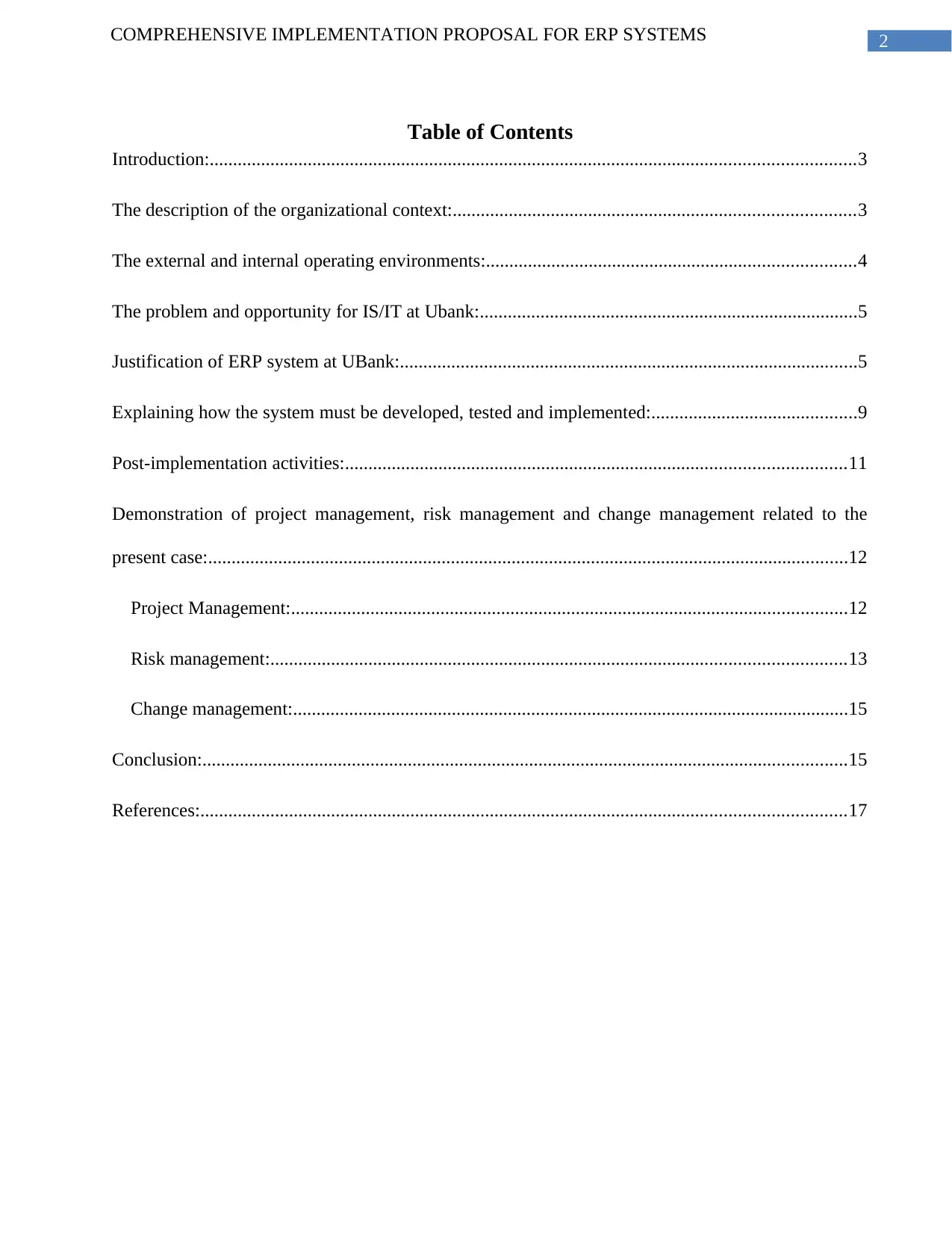
2COMPREHENSIVE IMPLEMENTATION PROPOSAL FOR ERP SYSTEMS
Table of Contents
Introduction:..........................................................................................................................................3
The description of the organizational context:......................................................................................3
The external and internal operating environments:...............................................................................4
The problem and opportunity for IS/IT at Ubank:.................................................................................5
Justification of ERP system at UBank:..................................................................................................5
Explaining how the system must be developed, tested and implemented:............................................9
Post-implementation activities:...........................................................................................................11
Demonstration of project management, risk management and change management related to the
present case:.........................................................................................................................................12
Project Management:.......................................................................................................................12
Risk management:...........................................................................................................................13
Change management:.......................................................................................................................15
Conclusion:..........................................................................................................................................15
References:..........................................................................................................................................17
Table of Contents
Introduction:..........................................................................................................................................3
The description of the organizational context:......................................................................................3
The external and internal operating environments:...............................................................................4
The problem and opportunity for IS/IT at Ubank:.................................................................................5
Justification of ERP system at UBank:..................................................................................................5
Explaining how the system must be developed, tested and implemented:............................................9
Post-implementation activities:...........................................................................................................11
Demonstration of project management, risk management and change management related to the
present case:.........................................................................................................................................12
Project Management:.......................................................................................................................12
Risk management:...........................................................................................................................13
Change management:.......................................................................................................................15
Conclusion:..........................................................................................................................................15
References:..........................................................................................................................................17
⊘ This is a preview!⊘
Do you want full access?
Subscribe today to unlock all pages.

Trusted by 1+ million students worldwide
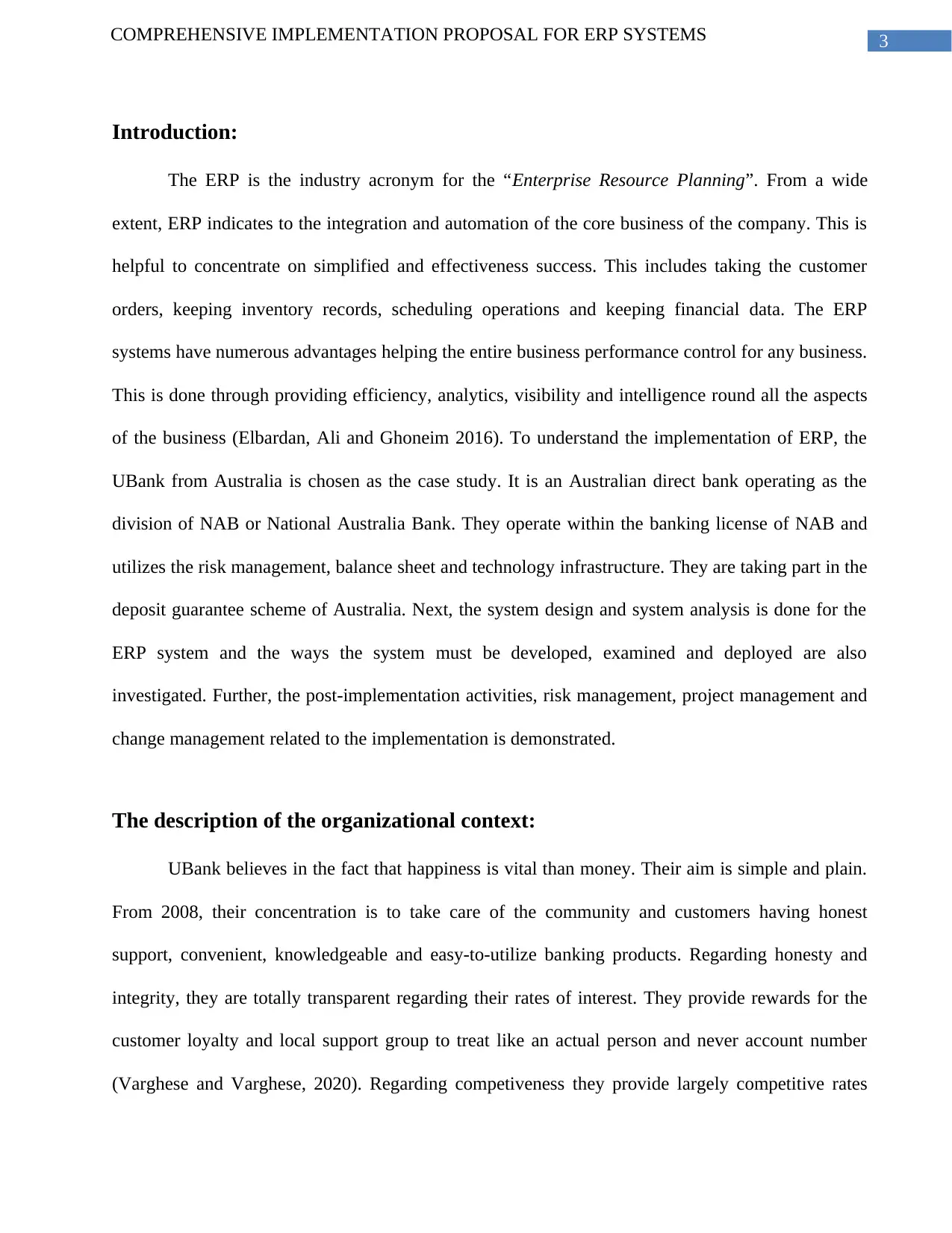
3COMPREHENSIVE IMPLEMENTATION PROPOSAL FOR ERP SYSTEMS
Introduction:
The ERP is the industry acronym for the “Enterprise Resource Planning”. From a wide
extent, ERP indicates to the integration and automation of the core business of the company. This is
helpful to concentrate on simplified and effectiveness success. This includes taking the customer
orders, keeping inventory records, scheduling operations and keeping financial data. The ERP
systems have numerous advantages helping the entire business performance control for any business.
This is done through providing efficiency, analytics, visibility and intelligence round all the aspects
of the business (Elbardan, Ali and Ghoneim 2016). To understand the implementation of ERP, the
UBank from Australia is chosen as the case study. It is an Australian direct bank operating as the
division of NAB or National Australia Bank. They operate within the banking license of NAB and
utilizes the risk management, balance sheet and technology infrastructure. They are taking part in the
deposit guarantee scheme of Australia. Next, the system design and system analysis is done for the
ERP system and the ways the system must be developed, examined and deployed are also
investigated. Further, the post-implementation activities, risk management, project management and
change management related to the implementation is demonstrated.
The description of the organizational context:
UBank believes in the fact that happiness is vital than money. Their aim is simple and plain.
From 2008, their concentration is to take care of the community and customers having honest
support, convenient, knowledgeable and easy-to-utilize banking products. Regarding honesty and
integrity, they are totally transparent regarding their rates of interest. They provide rewards for the
customer loyalty and local support group to treat like an actual person and never account number
(Varghese and Varghese, 2020). Regarding competiveness they provide largely competitive rates
Introduction:
The ERP is the industry acronym for the “Enterprise Resource Planning”. From a wide
extent, ERP indicates to the integration and automation of the core business of the company. This is
helpful to concentrate on simplified and effectiveness success. This includes taking the customer
orders, keeping inventory records, scheduling operations and keeping financial data. The ERP
systems have numerous advantages helping the entire business performance control for any business.
This is done through providing efficiency, analytics, visibility and intelligence round all the aspects
of the business (Elbardan, Ali and Ghoneim 2016). To understand the implementation of ERP, the
UBank from Australia is chosen as the case study. It is an Australian direct bank operating as the
division of NAB or National Australia Bank. They operate within the banking license of NAB and
utilizes the risk management, balance sheet and technology infrastructure. They are taking part in the
deposit guarantee scheme of Australia. Next, the system design and system analysis is done for the
ERP system and the ways the system must be developed, examined and deployed are also
investigated. Further, the post-implementation activities, risk management, project management and
change management related to the implementation is demonstrated.
The description of the organizational context:
UBank believes in the fact that happiness is vital than money. Their aim is simple and plain.
From 2008, their concentration is to take care of the community and customers having honest
support, convenient, knowledgeable and easy-to-utilize banking products. Regarding honesty and
integrity, they are totally transparent regarding their rates of interest. They provide rewards for the
customer loyalty and local support group to treat like an actual person and never account number
(Varghese and Varghese, 2020). Regarding competiveness they provide largely competitive rates
Paraphrase This Document
Need a fresh take? Get an instant paraphrase of this document with our AI Paraphraser
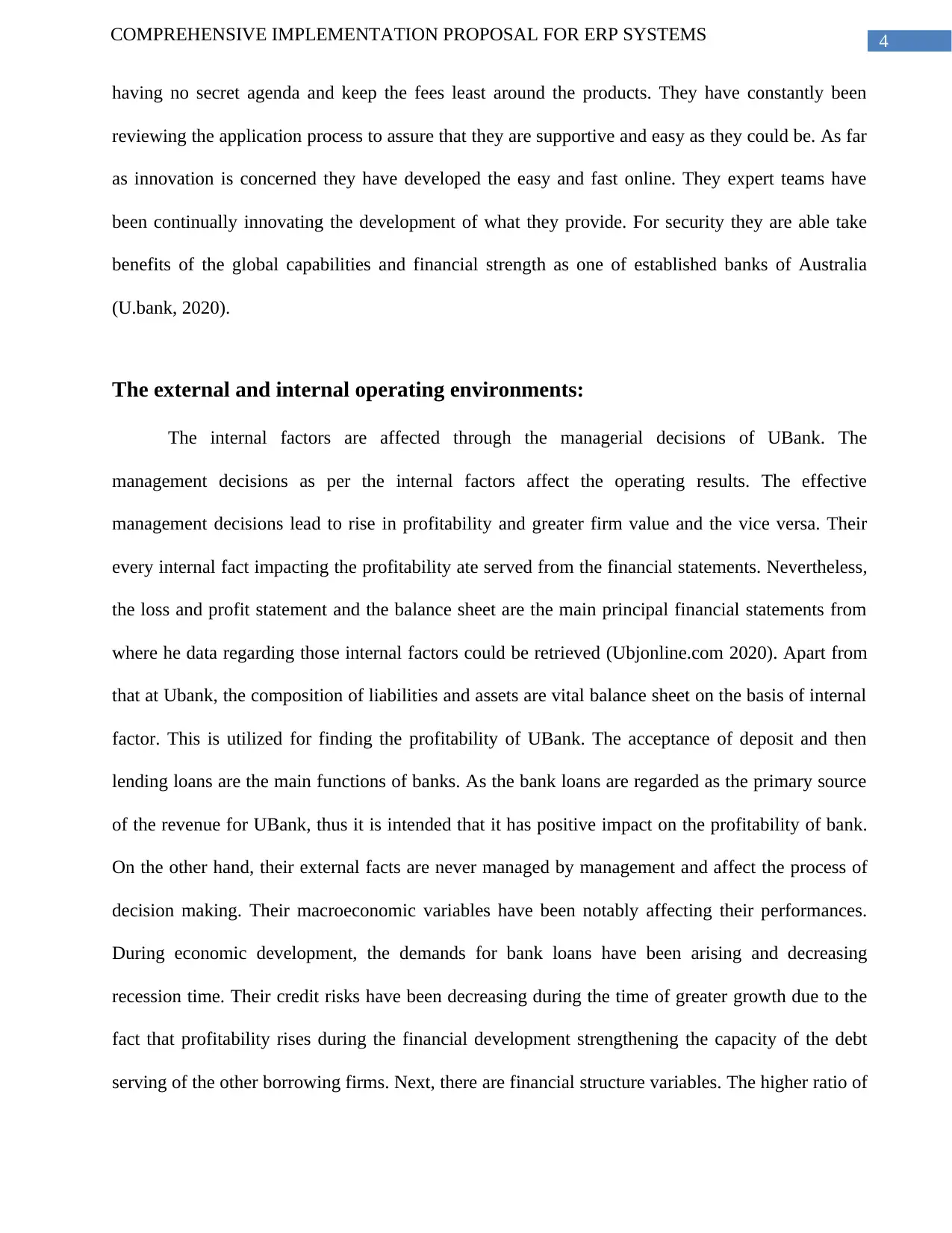
4COMPREHENSIVE IMPLEMENTATION PROPOSAL FOR ERP SYSTEMS
having no secret agenda and keep the fees least around the products. They have constantly been
reviewing the application process to assure that they are supportive and easy as they could be. As far
as innovation is concerned they have developed the easy and fast online. They expert teams have
been continually innovating the development of what they provide. For security they are able take
benefits of the global capabilities and financial strength as one of established banks of Australia
(U.bank, 2020).
The external and internal operating environments:
The internal factors are affected through the managerial decisions of UBank. The
management decisions as per the internal factors affect the operating results. The effective
management decisions lead to rise in profitability and greater firm value and the vice versa. Their
every internal fact impacting the profitability ate served from the financial statements. Nevertheless,
the loss and profit statement and the balance sheet are the main principal financial statements from
where he data regarding those internal factors could be retrieved (Ubjonline.com 2020). Apart from
that at Ubank, the composition of liabilities and assets are vital balance sheet on the basis of internal
factor. This is utilized for finding the profitability of UBank. The acceptance of deposit and then
lending loans are the main functions of banks. As the bank loans are regarded as the primary source
of the revenue for UBank, thus it is intended that it has positive impact on the profitability of bank.
On the other hand, their external facts are never managed by management and affect the process of
decision making. Their macroeconomic variables have been notably affecting their performances.
During economic development, the demands for bank loans have been arising and decreasing
recession time. Their credit risks have been decreasing during the time of greater growth due to the
fact that profitability rises during the financial development strengthening the capacity of the debt
serving of the other borrowing firms. Next, there are financial structure variables. The higher ratio of
having no secret agenda and keep the fees least around the products. They have constantly been
reviewing the application process to assure that they are supportive and easy as they could be. As far
as innovation is concerned they have developed the easy and fast online. They expert teams have
been continually innovating the development of what they provide. For security they are able take
benefits of the global capabilities and financial strength as one of established banks of Australia
(U.bank, 2020).
The external and internal operating environments:
The internal factors are affected through the managerial decisions of UBank. The
management decisions as per the internal factors affect the operating results. The effective
management decisions lead to rise in profitability and greater firm value and the vice versa. Their
every internal fact impacting the profitability ate served from the financial statements. Nevertheless,
the loss and profit statement and the balance sheet are the main principal financial statements from
where he data regarding those internal factors could be retrieved (Ubjonline.com 2020). Apart from
that at Ubank, the composition of liabilities and assets are vital balance sheet on the basis of internal
factor. This is utilized for finding the profitability of UBank. The acceptance of deposit and then
lending loans are the main functions of banks. As the bank loans are regarded as the primary source
of the revenue for UBank, thus it is intended that it has positive impact on the profitability of bank.
On the other hand, their external facts are never managed by management and affect the process of
decision making. Their macroeconomic variables have been notably affecting their performances.
During economic development, the demands for bank loans have been arising and decreasing
recession time. Their credit risks have been decreasing during the time of greater growth due to the
fact that profitability rises during the financial development strengthening the capacity of the debt
serving of the other borrowing firms. Next, there are financial structure variables. The higher ratio of
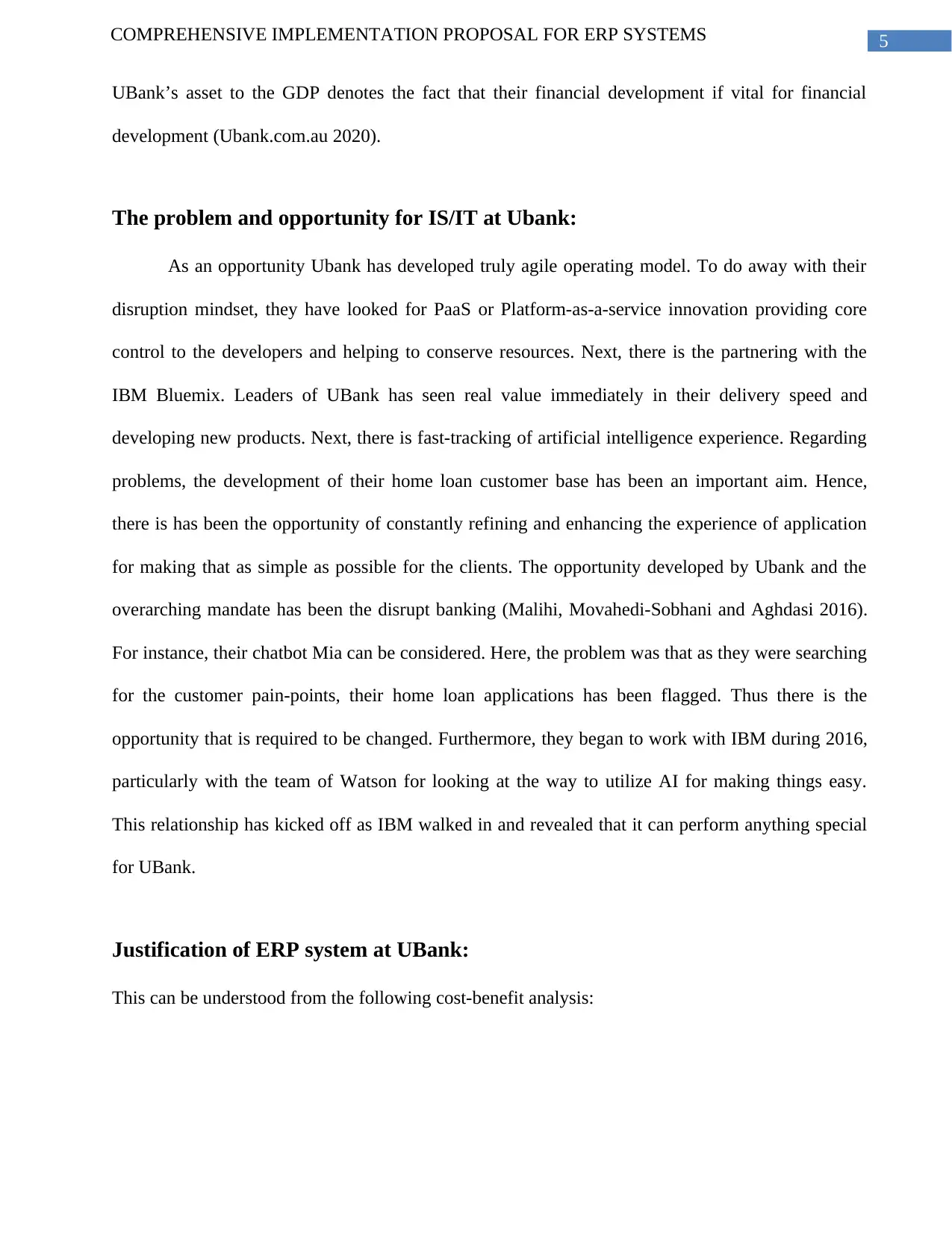
5COMPREHENSIVE IMPLEMENTATION PROPOSAL FOR ERP SYSTEMS
UBank’s asset to the GDP denotes the fact that their financial development if vital for financial
development (Ubank.com.au 2020).
The problem and opportunity for IS/IT at Ubank:
As an opportunity Ubank has developed truly agile operating model. To do away with their
disruption mindset, they have looked for PaaS or Platform-as-a-service innovation providing core
control to the developers and helping to conserve resources. Next, there is the partnering with the
IBM Bluemix. Leaders of UBank has seen real value immediately in their delivery speed and
developing new products. Next, there is fast-tracking of artificial intelligence experience. Regarding
problems, the development of their home loan customer base has been an important aim. Hence,
there is has been the opportunity of constantly refining and enhancing the experience of application
for making that as simple as possible for the clients. The opportunity developed by Ubank and the
overarching mandate has been the disrupt banking (Malihi, Movahedi-Sobhani and Aghdasi 2016).
For instance, their chatbot Mia can be considered. Here, the problem was that as they were searching
for the customer pain-points, their home loan applications has been flagged. Thus there is the
opportunity that is required to be changed. Furthermore, they began to work with IBM during 2016,
particularly with the team of Watson for looking at the way to utilize AI for making things easy.
This relationship has kicked off as IBM walked in and revealed that it can perform anything special
for UBank.
Justification of ERP system at UBank:
This can be understood from the following cost-benefit analysis:
UBank’s asset to the GDP denotes the fact that their financial development if vital for financial
development (Ubank.com.au 2020).
The problem and opportunity for IS/IT at Ubank:
As an opportunity Ubank has developed truly agile operating model. To do away with their
disruption mindset, they have looked for PaaS or Platform-as-a-service innovation providing core
control to the developers and helping to conserve resources. Next, there is the partnering with the
IBM Bluemix. Leaders of UBank has seen real value immediately in their delivery speed and
developing new products. Next, there is fast-tracking of artificial intelligence experience. Regarding
problems, the development of their home loan customer base has been an important aim. Hence,
there is has been the opportunity of constantly refining and enhancing the experience of application
for making that as simple as possible for the clients. The opportunity developed by Ubank and the
overarching mandate has been the disrupt banking (Malihi, Movahedi-Sobhani and Aghdasi 2016).
For instance, their chatbot Mia can be considered. Here, the problem was that as they were searching
for the customer pain-points, their home loan applications has been flagged. Thus there is the
opportunity that is required to be changed. Furthermore, they began to work with IBM during 2016,
particularly with the team of Watson for looking at the way to utilize AI for making things easy.
This relationship has kicked off as IBM walked in and revealed that it can perform anything special
for UBank.
Justification of ERP system at UBank:
This can be understood from the following cost-benefit analysis:
⊘ This is a preview!⊘
Do you want full access?
Subscribe today to unlock all pages.

Trusted by 1+ million students worldwide
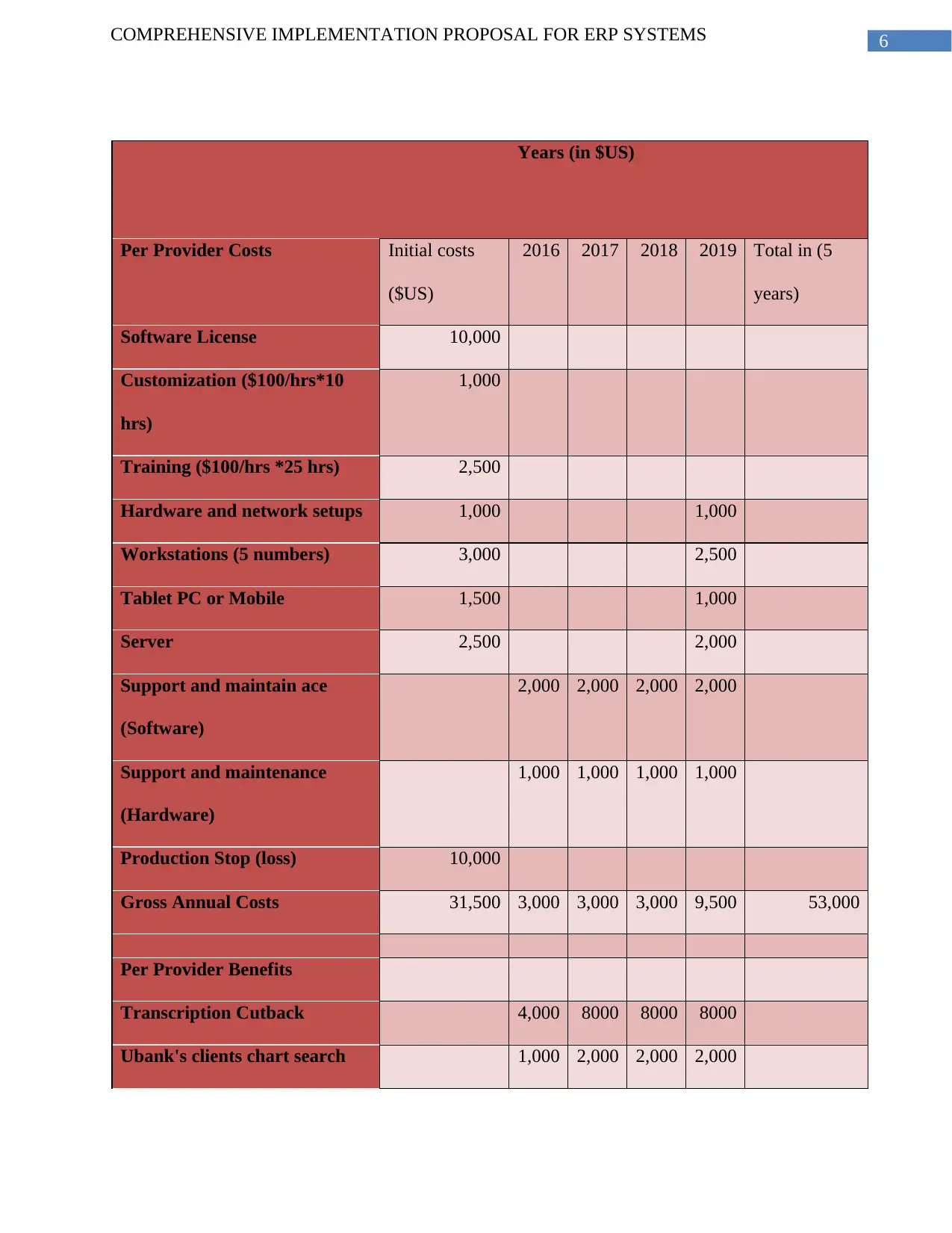
6COMPREHENSIVE IMPLEMENTATION PROPOSAL FOR ERP SYSTEMS
Years (in $US)
Per Provider Costs Initial costs
($US)
2016 2017 2018 2019 Total in (5
years)
Software License 10,000
Customization ($100/hrs*10
hrs)
1,000
Training ($100/hrs *25 hrs) 2,500
Hardware and network setups 1,000 1,000
Workstations (5 numbers) 3,000 2,500
Tablet PC or Mobile 1,500 1,000
Server 2,500 2,000
Support and maintain ace
(Software)
2,000 2,000 2,000 2,000
Support and maintenance
(Hardware)
1,000 1,000 1,000 1,000
Production Stop (loss) 10,000
Gross Annual Costs 31,500 3,000 3,000 3,000 9,500 53,000
Per Provider Benefits
Transcription Cutback 4,000 8000 8000 8000
Ubank's clients chart search 1,000 2,000 2,000 2,000
Years (in $US)
Per Provider Costs Initial costs
($US)
2016 2017 2018 2019 Total in (5
years)
Software License 10,000
Customization ($100/hrs*10
hrs)
1,000
Training ($100/hrs *25 hrs) 2,500
Hardware and network setups 1,000 1,000
Workstations (5 numbers) 3,000 2,500
Tablet PC or Mobile 1,500 1,000
Server 2,500 2,000
Support and maintain ace
(Software)
2,000 2,000 2,000 2,000
Support and maintenance
(Hardware)
1,000 1,000 1,000 1,000
Production Stop (loss) 10,000
Gross Annual Costs 31,500 3,000 3,000 3,000 9,500 53,000
Per Provider Benefits
Transcription Cutback 4,000 8000 8000 8000
Ubank's clients chart search 1,000 2,000 2,000 2,000
Paraphrase This Document
Need a fresh take? Get an instant paraphrase of this document with our AI Paraphraser
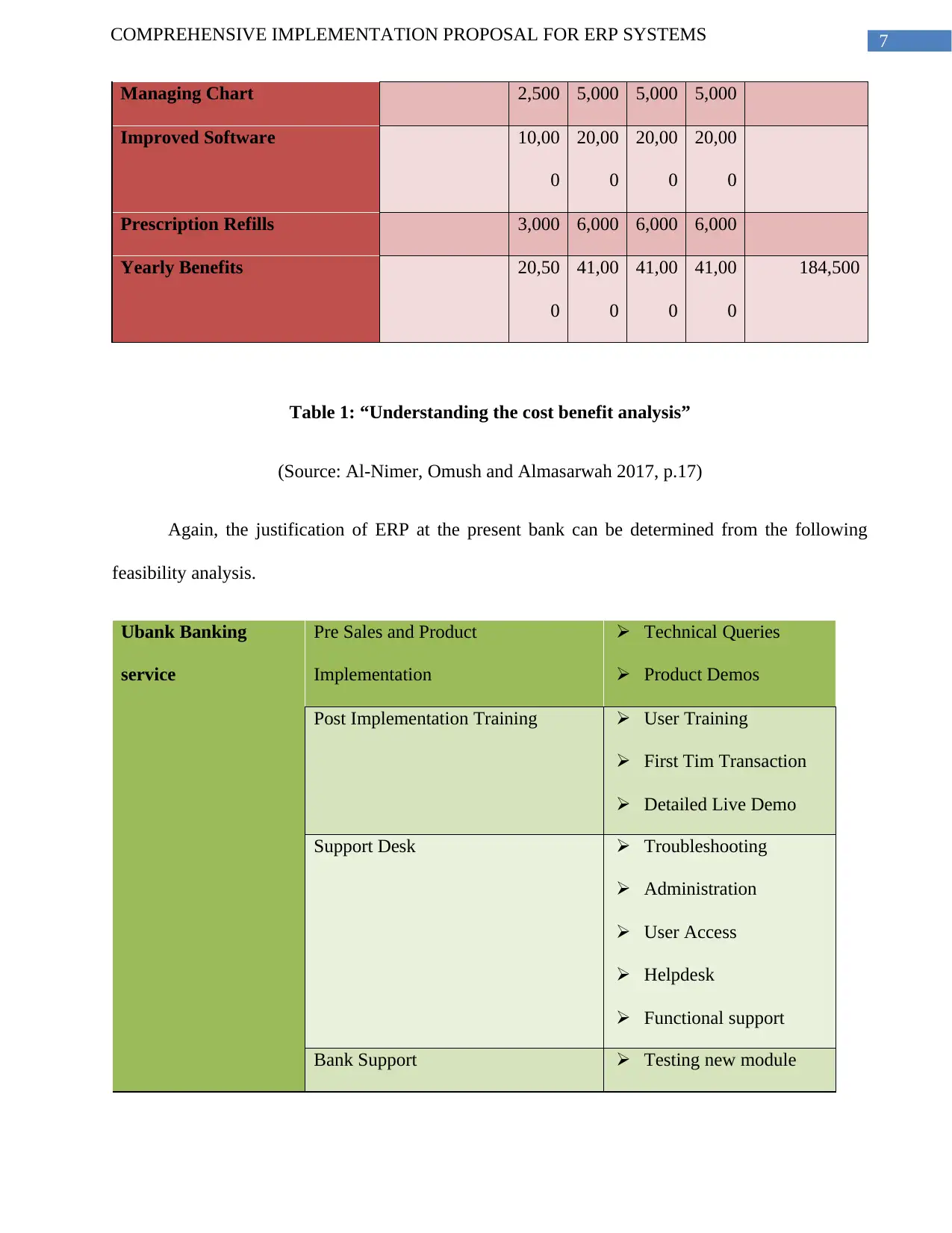
7COMPREHENSIVE IMPLEMENTATION PROPOSAL FOR ERP SYSTEMS
Managing Chart 2,500 5,000 5,000 5,000
Improved Software 10,00
0
20,00
0
20,00
0
20,00
0
Prescription Refills 3,000 6,000 6,000 6,000
Yearly Benefits 20,50
0
41,00
0
41,00
0
41,00
0
184,500
Table 1: “Understanding the cost benefit analysis”
(Source: Al-Nimer, Omush and Almasarwah 2017, p.17)
Again, the justification of ERP at the present bank can be determined from the following
feasibility analysis.
Ubank Banking
service
Pre Sales and Product
Implementation
Technical Queries
Product Demos
Post Implementation Training User Training
First Tim Transaction
Detailed Live Demo
Support Desk Troubleshooting
Administration
User Access
Helpdesk
Functional support
Bank Support Testing new module
Managing Chart 2,500 5,000 5,000 5,000
Improved Software 10,00
0
20,00
0
20,00
0
20,00
0
Prescription Refills 3,000 6,000 6,000 6,000
Yearly Benefits 20,50
0
41,00
0
41,00
0
41,00
0
184,500
Table 1: “Understanding the cost benefit analysis”
(Source: Al-Nimer, Omush and Almasarwah 2017, p.17)
Again, the justification of ERP at the present bank can be determined from the following
feasibility analysis.
Ubank Banking
service
Pre Sales and Product
Implementation
Technical Queries
Product Demos
Post Implementation Training User Training
First Tim Transaction
Detailed Live Demo
Support Desk Troubleshooting
Administration
User Access
Helpdesk
Functional support
Bank Support Testing new module
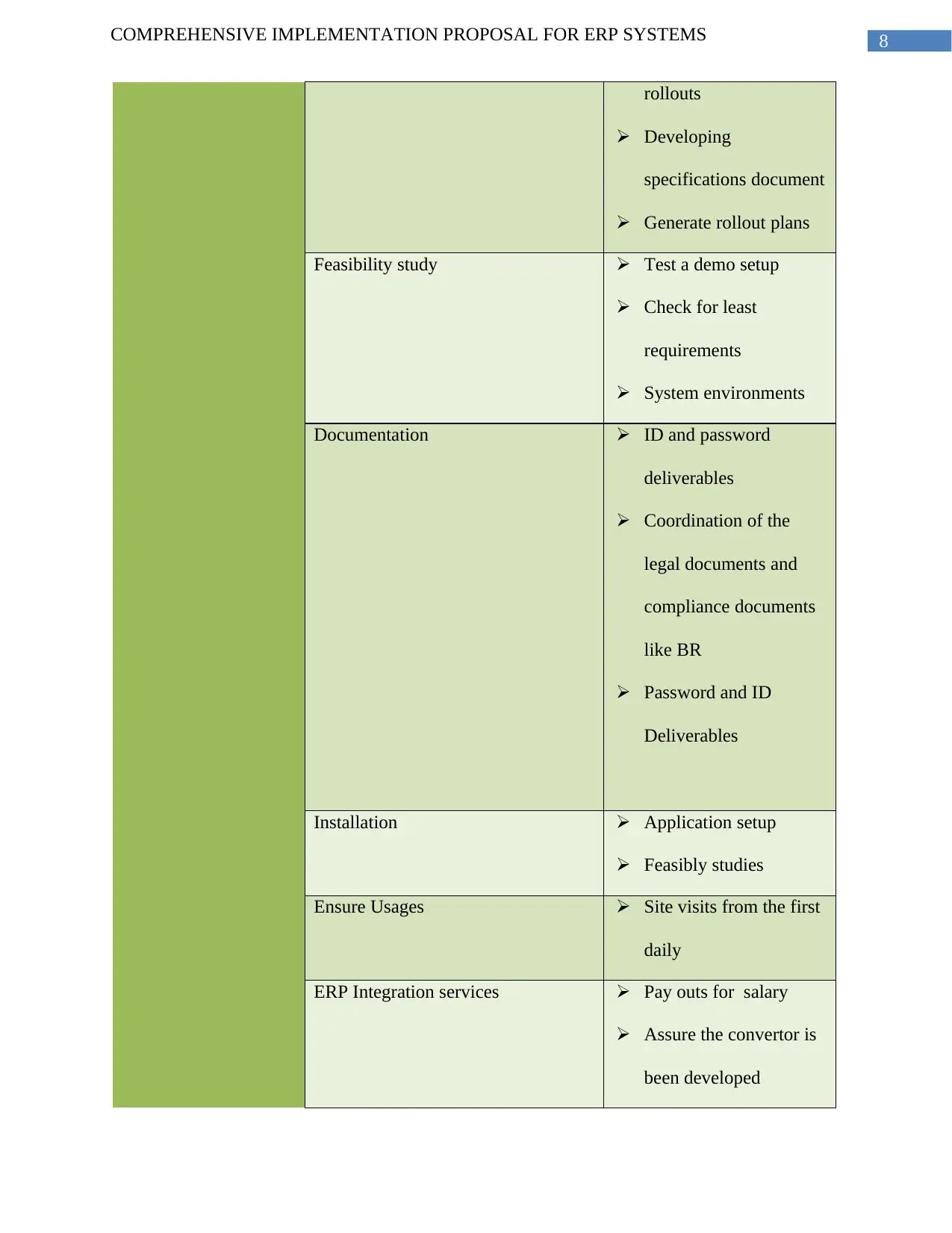
8COMPREHENSIVE IMPLEMENTATION PROPOSAL FOR ERP SYSTEMS
rollouts
Developing
specifications document
Generate rollout plans
Feasibility study Test a demo setup
Check for least
requirements
System environments
Documentation ID and password
deliverables
Coordination of the
legal documents and
compliance documents
like BR
Password and ID
Deliverables
Installation Application setup
Feasibly studies
Ensure Usages Site visits from the first
daily
ERP Integration services Pay outs for salary
Assure the convertor is
been developed
rollouts
Developing
specifications document
Generate rollout plans
Feasibility study Test a demo setup
Check for least
requirements
System environments
Documentation ID and password
deliverables
Coordination of the
legal documents and
compliance documents
like BR
Password and ID
Deliverables
Installation Application setup
Feasibly studies
Ensure Usages Site visits from the first
daily
ERP Integration services Pay outs for salary
Assure the convertor is
been developed
⊘ This is a preview!⊘
Do you want full access?
Subscribe today to unlock all pages.

Trusted by 1+ million students worldwide
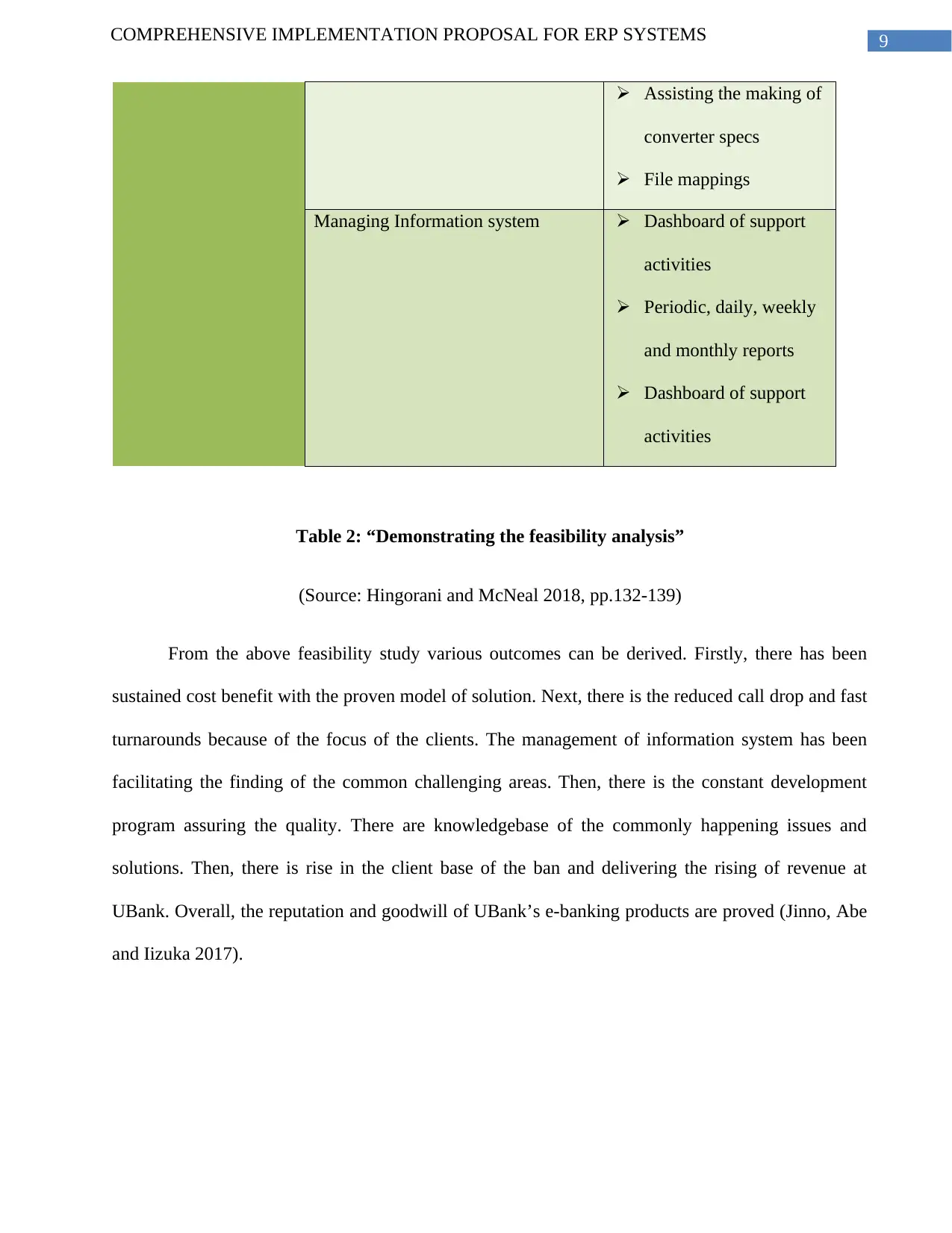
9COMPREHENSIVE IMPLEMENTATION PROPOSAL FOR ERP SYSTEMS
Assisting the making of
converter specs
File mappings
Managing Information system Dashboard of support
activities
Periodic, daily, weekly
and monthly reports
Dashboard of support
activities
Table 2: “Demonstrating the feasibility analysis”
(Source: Hingorani and McNeal 2018, pp.132-139)
From the above feasibility study various outcomes can be derived. Firstly, there has been
sustained cost benefit with the proven model of solution. Next, there is the reduced call drop and fast
turnarounds because of the focus of the clients. The management of information system has been
facilitating the finding of the common challenging areas. Then, there is the constant development
program assuring the quality. There are knowledgebase of the commonly happening issues and
solutions. Then, there is rise in the client base of the ban and delivering the rising of revenue at
UBank. Overall, the reputation and goodwill of UBank’s e-banking products are proved (Jinno, Abe
and Iizuka 2017).
Assisting the making of
converter specs
File mappings
Managing Information system Dashboard of support
activities
Periodic, daily, weekly
and monthly reports
Dashboard of support
activities
Table 2: “Demonstrating the feasibility analysis”
(Source: Hingorani and McNeal 2018, pp.132-139)
From the above feasibility study various outcomes can be derived. Firstly, there has been
sustained cost benefit with the proven model of solution. Next, there is the reduced call drop and fast
turnarounds because of the focus of the clients. The management of information system has been
facilitating the finding of the common challenging areas. Then, there is the constant development
program assuring the quality. There are knowledgebase of the commonly happening issues and
solutions. Then, there is rise in the client base of the ban and delivering the rising of revenue at
UBank. Overall, the reputation and goodwill of UBank’s e-banking products are proved (Jinno, Abe
and Iizuka 2017).
Paraphrase This Document
Need a fresh take? Get an instant paraphrase of this document with our AI Paraphraser
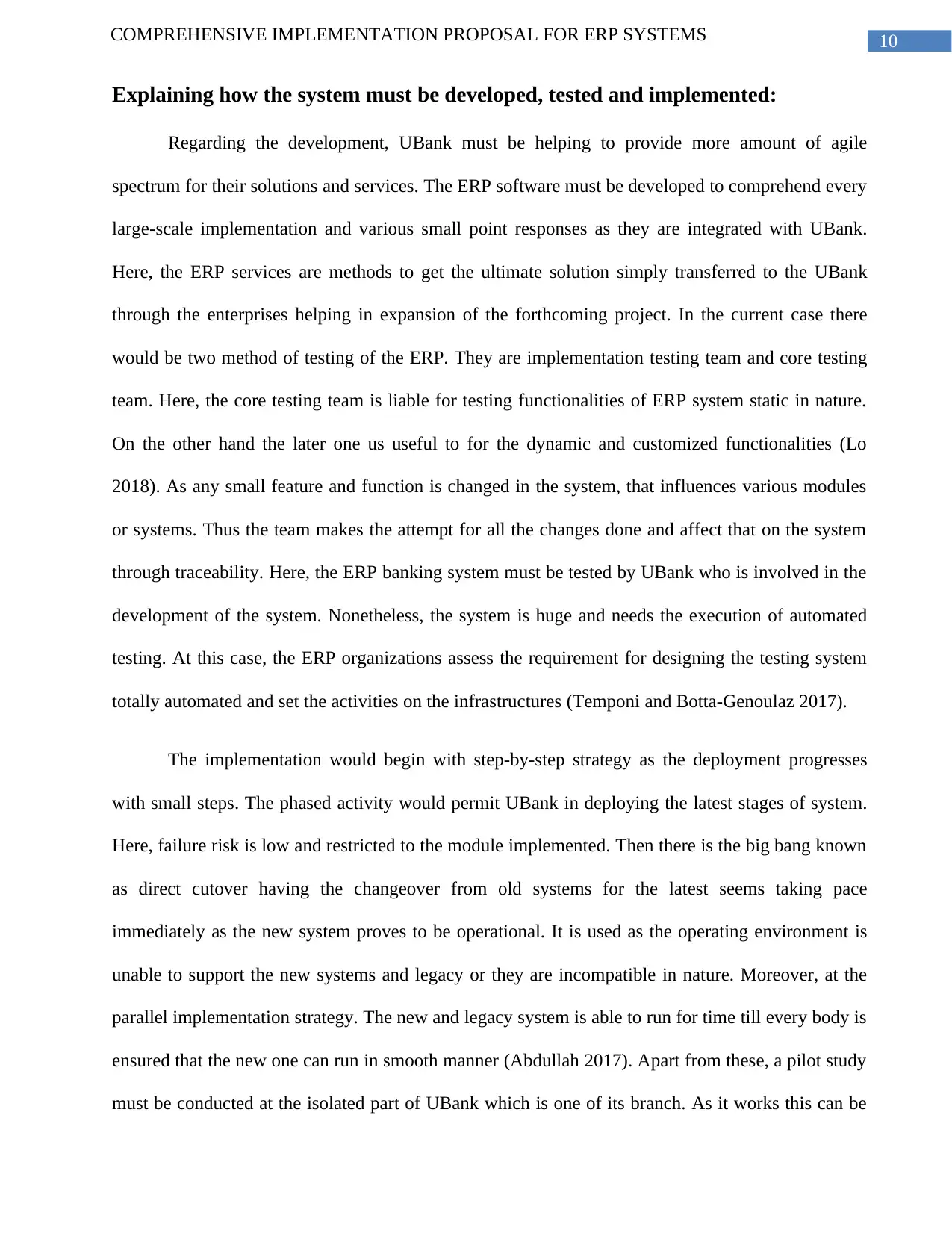
10COMPREHENSIVE IMPLEMENTATION PROPOSAL FOR ERP SYSTEMS
Explaining how the system must be developed, tested and implemented:
Regarding the development, UBank must be helping to provide more amount of agile
spectrum for their solutions and services. The ERP software must be developed to comprehend every
large-scale implementation and various small point responses as they are integrated with UBank.
Here, the ERP services are methods to get the ultimate solution simply transferred to the UBank
through the enterprises helping in expansion of the forthcoming project. In the current case there
would be two method of testing of the ERP. They are implementation testing team and core testing
team. Here, the core testing team is liable for testing functionalities of ERP system static in nature.
On the other hand the later one us useful to for the dynamic and customized functionalities (Lo
2018). As any small feature and function is changed in the system, that influences various modules
or systems. Thus the team makes the attempt for all the changes done and affect that on the system
through traceability. Here, the ERP banking system must be tested by UBank who is involved in the
development of the system. Nonetheless, the system is huge and needs the execution of automated
testing. At this case, the ERP organizations assess the requirement for designing the testing system
totally automated and set the activities on the infrastructures (Temponi and Botta-Genoulaz 2017).
The implementation would begin with step-by-step strategy as the deployment progresses
with small steps. The phased activity would permit UBank in deploying the latest stages of system.
Here, failure risk is low and restricted to the module implemented. Then there is the big bang known
as direct cutover having the changeover from old systems for the latest seems taking pace
immediately as the new system proves to be operational. It is used as the operating environment is
unable to support the new systems and legacy or they are incompatible in nature. Moreover, at the
parallel implementation strategy. The new and legacy system is able to run for time till every body is
ensured that the new one can run in smooth manner (Abdullah 2017). Apart from these, a pilot study
must be conducted at the isolated part of UBank which is one of its branch. As it works this can be
Explaining how the system must be developed, tested and implemented:
Regarding the development, UBank must be helping to provide more amount of agile
spectrum for their solutions and services. The ERP software must be developed to comprehend every
large-scale implementation and various small point responses as they are integrated with UBank.
Here, the ERP services are methods to get the ultimate solution simply transferred to the UBank
through the enterprises helping in expansion of the forthcoming project. In the current case there
would be two method of testing of the ERP. They are implementation testing team and core testing
team. Here, the core testing team is liable for testing functionalities of ERP system static in nature.
On the other hand the later one us useful to for the dynamic and customized functionalities (Lo
2018). As any small feature and function is changed in the system, that influences various modules
or systems. Thus the team makes the attempt for all the changes done and affect that on the system
through traceability. Here, the ERP banking system must be tested by UBank who is involved in the
development of the system. Nonetheless, the system is huge and needs the execution of automated
testing. At this case, the ERP organizations assess the requirement for designing the testing system
totally automated and set the activities on the infrastructures (Temponi and Botta-Genoulaz 2017).
The implementation would begin with step-by-step strategy as the deployment progresses
with small steps. The phased activity would permit UBank in deploying the latest stages of system.
Here, failure risk is low and restricted to the module implemented. Then there is the big bang known
as direct cutover having the changeover from old systems for the latest seems taking pace
immediately as the new system proves to be operational. It is used as the operating environment is
unable to support the new systems and legacy or they are incompatible in nature. Moreover, at the
parallel implementation strategy. The new and legacy system is able to run for time till every body is
ensured that the new one can run in smooth manner (Abdullah 2017). Apart from these, a pilot study
must be conducted at the isolated part of UBank which is one of its branch. As it works this can be
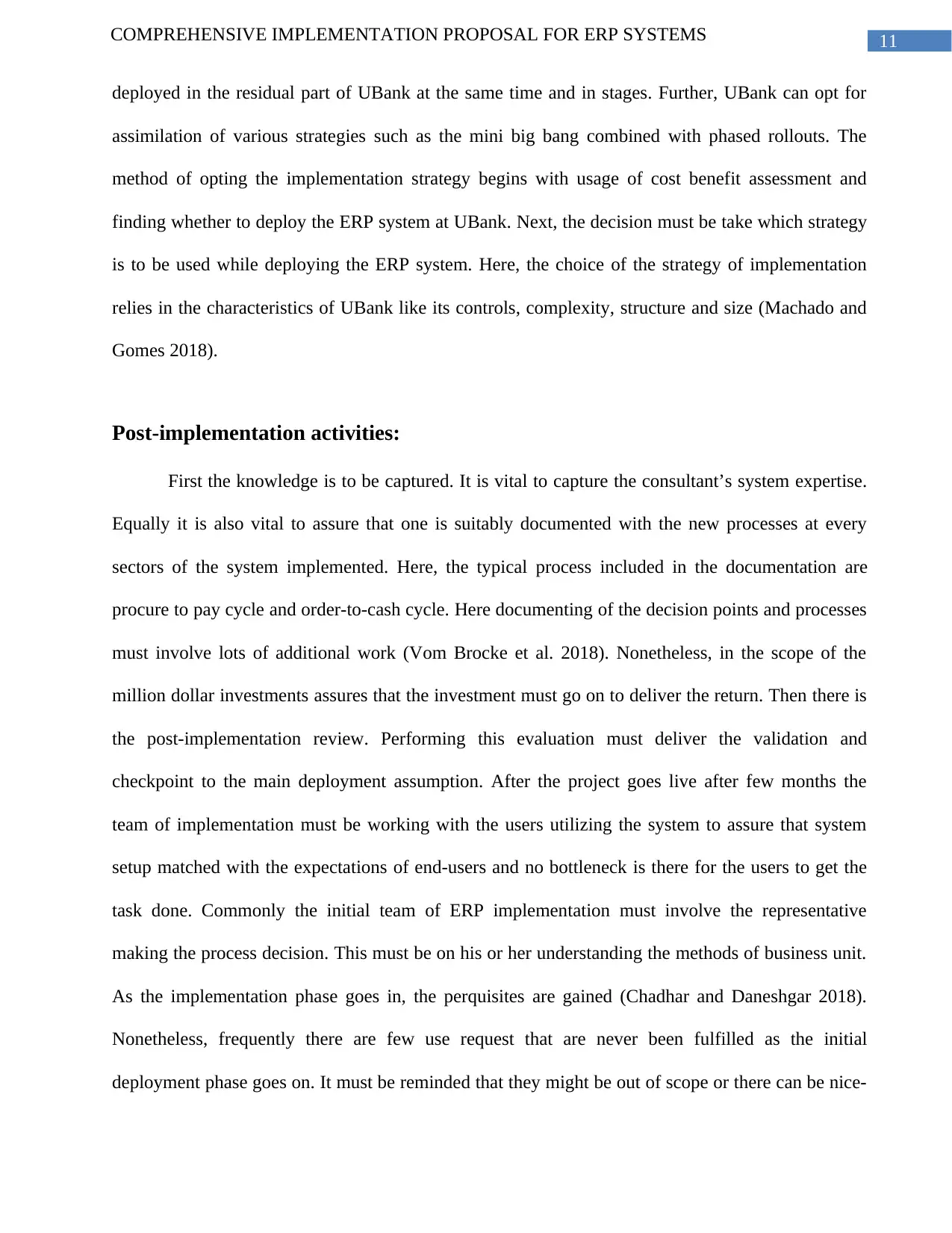
11COMPREHENSIVE IMPLEMENTATION PROPOSAL FOR ERP SYSTEMS
deployed in the residual part of UBank at the same time and in stages. Further, UBank can opt for
assimilation of various strategies such as the mini big bang combined with phased rollouts. The
method of opting the implementation strategy begins with usage of cost benefit assessment and
finding whether to deploy the ERP system at UBank. Next, the decision must be take which strategy
is to be used while deploying the ERP system. Here, the choice of the strategy of implementation
relies in the characteristics of UBank like its controls, complexity, structure and size (Machado and
Gomes 2018).
Post-implementation activities:
First the knowledge is to be captured. It is vital to capture the consultant’s system expertise.
Equally it is also vital to assure that one is suitably documented with the new processes at every
sectors of the system implemented. Here, the typical process included in the documentation are
procure to pay cycle and order-to-cash cycle. Here documenting of the decision points and processes
must involve lots of additional work (Vom Brocke et al. 2018). Nonetheless, in the scope of the
million dollar investments assures that the investment must go on to deliver the return. Then there is
the post-implementation review. Performing this evaluation must deliver the validation and
checkpoint to the main deployment assumption. After the project goes live after few months the
team of implementation must be working with the users utilizing the system to assure that system
setup matched with the expectations of end-users and no bottleneck is there for the users to get the
task done. Commonly the initial team of ERP implementation must involve the representative
making the process decision. This must be on his or her understanding the methods of business unit.
As the implementation phase goes in, the perquisites are gained (Chadhar and Daneshgar 2018).
Nonetheless, frequently there are few use request that are never been fulfilled as the initial
deployment phase goes on. It must be reminded that they might be out of scope or there can be nice-
deployed in the residual part of UBank at the same time and in stages. Further, UBank can opt for
assimilation of various strategies such as the mini big bang combined with phased rollouts. The
method of opting the implementation strategy begins with usage of cost benefit assessment and
finding whether to deploy the ERP system at UBank. Next, the decision must be take which strategy
is to be used while deploying the ERP system. Here, the choice of the strategy of implementation
relies in the characteristics of UBank like its controls, complexity, structure and size (Machado and
Gomes 2018).
Post-implementation activities:
First the knowledge is to be captured. It is vital to capture the consultant’s system expertise.
Equally it is also vital to assure that one is suitably documented with the new processes at every
sectors of the system implemented. Here, the typical process included in the documentation are
procure to pay cycle and order-to-cash cycle. Here documenting of the decision points and processes
must involve lots of additional work (Vom Brocke et al. 2018). Nonetheless, in the scope of the
million dollar investments assures that the investment must go on to deliver the return. Then there is
the post-implementation review. Performing this evaluation must deliver the validation and
checkpoint to the main deployment assumption. After the project goes live after few months the
team of implementation must be working with the users utilizing the system to assure that system
setup matched with the expectations of end-users and no bottleneck is there for the users to get the
task done. Commonly the initial team of ERP implementation must involve the representative
making the process decision. This must be on his or her understanding the methods of business unit.
As the implementation phase goes in, the perquisites are gained (Chadhar and Daneshgar 2018).
Nonetheless, frequently there are few use request that are never been fulfilled as the initial
deployment phase goes on. It must be reminded that they might be out of scope or there can be nice-
⊘ This is a preview!⊘
Do you want full access?
Subscribe today to unlock all pages.

Trusted by 1+ million students worldwide
1 out of 19
Related Documents
Your All-in-One AI-Powered Toolkit for Academic Success.
+13062052269
info@desklib.com
Available 24*7 on WhatsApp / Email
![[object Object]](/_next/static/media/star-bottom.7253800d.svg)
Unlock your academic potential
Copyright © 2020–2025 A2Z Services. All Rights Reserved. Developed and managed by ZUCOL.




